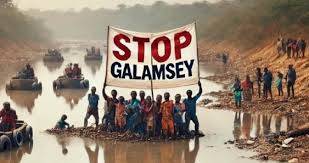**The Crisis of Illegal Galamsey Mining in Ghana: Effects and Solutions
Illegal mining, locally known as "Galamsey," has become one of the most pressing environmental and socio-economic issues in Ghana. Originally a small-scale, informal activity, Galamsey has grown into a significant problem, driven by the lure of gold and fueled by inadequate regulatory oversight. This article explores the multifaceted impacts of illegal Galamsey mining on Ghana's environment, economy, and society, and proposes strategies for finding sustainable solutions.
### The Emergence of Galamsey
Galamsey, derived from the English phrase "gather them and sell," refers to unauthorized gold mining operations. Historically, Ghana’s mining industry was largely dominated by formal, large-scale operations. However, the gold rush era attracted numerous individuals and groups seeking to tap into the country’s mineral wealth. The lack of effective regulation and oversight allowed Galamsey to proliferate, particularly in rural and forested areas.
### Environmental Consequences
The environmental impact of Galamsey is profound and distressing. The mining methods used are typically rudimentary and environmentally destructive. Traditional techniques involve the use of toxic chemicals like mercury and cyanide to extract gold from ore. These chemicals are often improperly handled and disposed of, leading to severe contamination of soil and water sources.
**1. Water Pollution:**
One of the most visible consequences is the pollution of water bodies. Mercury, a common byproduct of illegal mining, enters rivers and streams, poisoning aquatic life and making water unsafe for human consumption. This contamination disrupts ecosystems, leading to the loss of biodiversity and compromising water resources for local communities.
**2. Deforestation:** The expansion of mining sites leads to widespread deforestation. Forested areas are cleared to access mineral deposits, resulting in the loss of valuable forest ecosystems. This deforestation not only diminishes biodiversity but also disrupts the carbon sequestration process, contributing to climate change.
**3. Land Degradation:** The physical disturbance caused by mining operations leads to significant land degradation. Unrestored mining sites become barren, eroded landscapes, which are difficult to rehabilitate. The loss of arable land affects agriculture, which is a primary livelihood for many Ghanaians.
### Socio-Economic Impacts
Beyond environmental damage, Galamsey also has severe socio-economic repercussions.
**1. Health Hazards:** The use of mercury and other chemicals in illegal mining poses serious health risks. Workers and nearby communities are exposed to toxic substances, leading to chronic health conditions such as respiratory problems, neurological damage, and skin disorders. The long-term effects are often devastating and contribute to a growing public health crisis.
**2. Economic Impact:** While Galamsey provides immediate economic benefits to miners and some local communities, it undermines long-term economic stability. The destruction of natural resources affects industries reliant on these resources, such as agriculture and tourism. Furthermore, the loss of mineral wealth due to unregulated mining deprives the government of potential revenue.
**3. Social Conflicts:** The competition for gold resources often leads to conflicts among miners, local communities, and even between different ethnic groups. Disputes over land rights and mining sites can escalate into violence, further destabilizing communities.
### Regulatory Challenges
Addressing the problem of Galamsey requires a multifaceted approach, but the effectiveness of regulatory measures has been hampered by several challenges:
**1. Inadequate Enforcement:** Despite laws and regulations designed to control mining activities, enforcement is often weak. Corruption, lack of resources, and insufficient training for enforcement officers contribute to the ineffectiveness of regulatory bodies.
**2. Weak Legal Framework:** The legal framework governing small-scale mining is often outdated and inadequate. The lack of clear guidelines and distinctions between legal and illegal mining activities creates confusion and makes enforcement difficult.
**3. Socioeconomic Pressures:** Many individuals turn to Galamsey out of economic necessity. The lack of alternative livelihoods in rural areas compels people to engage in illegal mining, making it challenging to eradicate the practice without addressing the underlying socio-economic issues.
### Pathways to Sustainable Solutions
Finding lasting solutions to the Galamsey crisis requires a comprehensive approach that addresses environmental, social, and regulatory dimensions. Here are some potential strategies:
**1. Strengthening Regulation and Enforcement:** The government must enhance regulatory frameworks and enforcement mechanisms. This includes updating legal frameworks to better address the realities of small-scale mining and increasing funding and resources for enforcement agencies. Implementing more stringent penalties for illegal mining activities and improving transparency in the licensing process can also deter unlawful practices.
**2. Promoting Alternative Livelihoods:** To reduce the reliance on illegal mining, it is crucial to develop and promote alternative livelihoods for affected communities. This could involve investing in agricultural development, vocational training programs, and other income-generating activities. By providing viable alternatives, the economic allure of Galamsey can be diminished.
**3. Environmental Rehabilitation:** Restoration of degraded lands and polluted water bodies is essential. Initiatives should include reforestation projects, clean-up operations for contaminated water sources, and the rehabilitation of abandoned mining sites. Engaging local communities in these efforts can also promote environmental stewardship and sustainable practices.
**4. Community Engagement and Education:** Raising awareness about the dangers of illegal mining and the importance of environmental conservation is vital. Community engagement programs should focus on educating local populations about the long-term impacts of Galamsey and involve them in monitoring and reporting illegal activities. Building local capacity to manage and oversee mining activities can also enhance regulatory effectiveness.
**5. Collaboration with Stakeholders:** Addressing the Galamsey problem requires collaboration between various stakeholders, including government agencies, mining companies, non-governmental organizations, and local communities. Public-private partnerships can be instrumental in implementing effective solutions and ensuring that mining activities are conducted responsibly and sustainably.
**6. Technological Innovation:** Adopting and promoting cleaner mining technologies can help mitigate environmental damage. Investment in research and development of sustainable mining practices and the use of alternative methods that reduce reliance on harmful chemicals are crucial steps toward reducing the environmental footprint of mining activities.
### Conclusion
Illegal Galamsey mining in Ghana presents a complex challenge with far-reaching environmental, socio-economic, and regulatory implications. Addressing this issue requires a multifaceted approach that combines robust regulation, alternative livelihoods, environmental rehabilitation, community engagement, and technological innovation. By adopting these strategies, Ghana can work towards mitigating the negative impacts of Galamsey and fostering a more sustainable and equitable mining sector.


